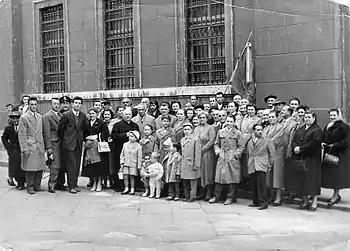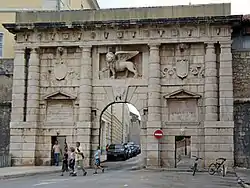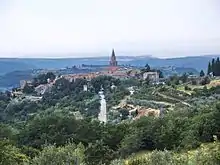Italian language in Croatia
The Italian language is an official minority language in Croatia, with many schools and public announcements published in both languages. Croatia's proximity and cultural connections to Italy have led to a relatively large presence of Italians in Croatia. Italians were recognized as a state minority in the Croatian Constitution in two sections: Istrian Italians and Dalmatian Italians. Although only 0.43% of the total population is Italian by citizenship, many more are ethnically Italian and a large percentage of Croatians speak Italian, in addition to Croatian.


As of 2009, the Italian language is officially used in twenty cities and municipalities and ten other settlements in Croatia, according to the European Charter for Regional or Minority Languages.[1] It is an officially recognized minority language in Istria County, where it is spoken by 6.83% of the population on the aggregate and closer to 50% of the population in certain subdivisions.[2]
Italian-speaking population

The 2011 Census in Croatia reported 17,807 ethnic Italians in the country (some 0.42% of the total population).[3] Ethnologue reported 70,000 persons whose first language is Italian or Venetian in 1998 (referring to Eugen Marinov's 1998 data). This population was composed of 30,000 ethnic Italians[4] and 40,000 ethnic Croats and persons declared regionally ("as Istrians"). Native Italian speakers are largely concentrated along the western coast of peninsula Istria. Because of Croatian trade and tourist relations with Italy, many Croats have some knowledge of the language (mostly in the service and tourist industries).
In Istrian contexts the word "Italian" can just as easily refer to autochthonous speakers of the Venetian language, who were present in the region before the inception of the Venetian Republic and of the Istriot language, the oldest spoken language in Istria, dating back to the Romans and now spoken in the south west of Istria in Rovigno, Valle, Dignano, Gallesano, Fasana, Valbandon, Sissano and the surroundings of Pola.
The term may sometimes refer to a descendant of colonized persons during the Benito Mussolini period (during that period immigration in Istria, Zadar/Zara and northern Adriatic islands, given to Italy after World War I, was promoted, 44,000 according to Žerjavić,[5]). It can also refer to Istrian Slavs who adopted Italian culture as they moved from rural to urban areas, or from the farms into the bourgeoisie.
History

In the past the language had a much larger population than it does now: the Italian (Venetian speaking) population constituted well over half of the population of Istria and (according to the Italian linguist Bartoli) nearly one third of Dalmatians in the second half of the 18th century. In Dalmatia, ethnic Italians underwent significant persecution in the 1800s, whereby, according to the Austrian census it had decreased from 22% in 1816 to 12.5% in 1853, down to a mere 2.9% in 1910.
After World War I Italy obtained Zara and some northern Dalmatian islands (Cherso and Lussino). During World War II the Kingdom of Italy annexed most of Dalmatia to the newly created Governatorato di Dalmazia. In 1942, 4020 Italians lived in these newly annexed areas: 2220 in Spalato (Split), 300 in Sebenico (Šibenik), 500 in Cattaro (Kotor) and 1000 in Veglia (Krk).
Furthermore, after World War I and the fall of the Austro-Hungarian Empire, 10,000 Italians in the Governatorato took Yugoslav citizenship so they could remain and be accepted by the new Yugoslavian state.[6]
In 1939 Italy conducted a covert census of the non-Italian population (Croats and Slovenes) in Istria, Kvarner, Zadar, Trieste and Gorizia. After the census, Italian authorities publicly stated that the Italian speaking population in those areas had increased. However, data proved that the share of Croatian speakers did not diminish in that period.[7]
For various reasons—mainly related to nationalism and armed conflict—the numbers of Italian speakers in Croatia declined during the 20th century, especially after the Second World War in a period known as the Istrian exodus, when about 90% Italian-speaking Istrians and Dalmatians left Yugoslav dominated areas in the eastern Adriatic. The 2001 census in Croatia reported 19,636 ethnic Italians in the country.[8]
Italian in use
_bilingual.jpg.webp)
In Istria County, local government services are provided in Croatian and Italian, including the tri-lingual (Croatian, Italian and English) official government website. There are some Italian-language schools in the region of Istria: primary schools in Buje/Buie, Umag/Umago, Novigrad/Cittanova d'Istria, Poreč/Parenzo, and secondary schools in Pula/Pola and Rovinj/Rovigno.
The city of Rijeka/Fiume in the Kvarner/Carnaro region has Italian kindergartens and elementary schools, and there is an Italian Secondary School in Rijeka.[9] The daily newspaper La Voce del Popolo, the main newspaper for Italian Croatians, is published in Rijeka/Fiume.
In 2013, the first Italian kindergarten in Dalmatia "Pinocchio" was opened in Zadar. Kindergarten "Pinocchio" is the first Italian educational institution opened in Dalmatia after the closure of the last Italian school, which operated there until 1953.
In various municipalities, census data shows that significant numbers of Italians still live in Istria, such as 51% of the population of Grožnjan/Grisignana, 37% at Brtonigla/Verteneglio, and nearly 30% in Buje/Buie.[10] In the village there, it is an important section of the "Comunità degli Italiani" in Croatia.[11]
See also
References
- "Europska povelja o regionalnim ili manjinskim jezicima" (in Croatian). Ministry of Justice (Croatia). 2011-04-12. Archived from the original on December 27, 2013. Retrieved 2012-02-08.
- "Population by Mother Tongue, by Towns/Municipalities, 2011 Census". Census of Population, Households and Dwellings 2011. Zagreb: Croatian Bureau of Statistics. December 2012.
- "Population by Ethnicity, by Towns/Municipalities, 2011 Census". Census of Population, Households and Dwellings 2011. Zagreb: Croatian Bureau of Statistics. December 2012.
- Ethnologue Ethnologue report for Croatia
- "Prešućivanje s poznatom namjerom". Vjesnik (in Croatian). May 28, 2003. Archived from the original on September 18, 2003.
- Rodogno, D. (2006). Fascism's European Empire: Italian Occupation During the Second World War. Cambridge University Press. pp. 4–72. ISBN 9780521845151. Retrieved November 30, 2014.
- Časopis za suvremenu povijest br. 3/2002. M. Manin: O povjerljivom popisivanju istarskih Hrvata provedenom 1939. godine (na temelju popisnoga materijala iz 1936. godine)
(Journal of Contemporary History: Secret Census of Istrian Croats held in 1939 based on 1936 Census Data), summary in English - "SAS Output". dzs.hr. Retrieved November 30, 2014.
- "Byron: the first language school in Istria". www.byronlang.net. Retrieved July 20, 2018.
- "SAS Output". dzs.hr. Retrieved November 30, 2014.
- "Comunità Nazionale Italiana, Unione Italiana". www.unione-italiana.hr. Retrieved July 20, 2018.